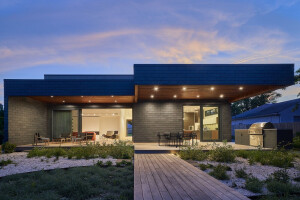The team of planners including bof Architects (Hamburg), IMS Ingenieurgesellschaft (Ham-burg) and m+p consulting (Brunswick) was able to win an open competition for the new con-struction of the Indian polar station in the Antarctic in December 2006. The contract was awarded by the National Center for Antarctic and Ocean Research (NCAOR) and planning commenced in spring of 2009.
The planning was conducted primarily in Hamburg and the coordinating meetings with the cli-ent were conducted every two months with the client in Goa, India. During the winter of 2010/2011 the infrastructural measures for the site were executed including the helipad, the pipelines and the kerosene tanks etc. The actual polar station structure was assembled during the winter of 2011/2012.
The location of the station is on a peninsula in the Larsmann Hills region in the northeast sec-tion of the Antarctic. The extreme climate conditions and the limited means of transportation required a special architectural solution in regards to the existing circumstances. Central as-pects in regards to the project include the following: redundancy, sustainability and mobility.
Due to the restricted accessibility to the region and considering the stipulations of the Antarc-tic Treaty, the station must be completely self-sufficient and constructed in a manner that al-lows for a complete disassembly.
The building is outfitted with a self-sufficient source of energy, heating and cooling systems and its own fresh water treatment system. The combined heat and power unit provides the energy for the station. The residual heat resulting from the production of electricity is more than sufficient to heat the entire station. The CHP unit and all other elements of the construc-tion required for living purposes are conceived in such a manner, that in the event an element should malfunction, a substitute element is available on site.
The building consists of 134 standard shipping containers that not only define the individual spaces, but which also account for the structural system. The high degree of mobility and fle-xibility associated with such containers provides for an optimal means of transport and extre-mely short assembly periods. The functions of the building are clearly structured and orga-nized. A total of 24 single and double rooms are located on the second floor as is a kitchen and dining room, a library, a fitness room, an OP room, as well as the offices and a lounge. The lower level houses the laboratories and the storage spaces, the technical spaces, the CHP unit as well as the garage which includes a workshop. The third level houses the air con-ditioning system as well as the terrace which can be used for diverse scientific experiments.
Due to the extreme conditions in the Antarctic, the extremely low temperatures and the po-werful winds, the containers have been clad with an insulated, aerodynamic skin consisting of metal panels. The form of the facade was tested in a wind canal and was optimized for this purpose. The primary goal was to minimize the build up of snowdrifts around the building to eliminate the chances of being snowed in. Additionally the effects of wind loads on the facade had to be reduced to a minimum. The ends of the stations are generously glazed and offer panoramic views of the ice and the sea from the dining room and the lounge.
The interior of the station is characterized by wood, diverse colors and ample daylight, all of which account for a comfortable workplace and a high quality sojourn.
During the summer months the station can house approximately 47 researchers and scien-tists and approximately 24 members during the winter.
The station, including a mock-up, was prefabricated in Duisburg during the summer of 2011. Subsequently the individual elements were shipped by way of Antwerp and Cape Town to the Antarctic for assembly purposes.
The assembly was completed within four months and was conducted during the short antarc-tic summer (November 2011 - March 2012). The station has a gross floor area of approximately 2.500 sqm and was finally completed in February 2013.
Bharati – New Indian Research Station on Larsemann Hills
Bharati is India’s third Antarctic research station and located at 69°’S/76°’E on a peninsula of Larsemann Hills. The proximity to the coast exposes it to extreme katabatic winds with gusts of 200 mph in ultimate limit state, temperatures of -40°C and high corrosivity. The entire design speaks of functions and constraints. Timely and logistical constraints like vessel transport, short construction periods and the Antarctic Protocol called for 20 foot ISO containers as the main building components. Such containers provide easy handling, transport, assembly and disassembly and have therefore become a standard for Antarctic buildings. However, the target was to utilise the container material as much as possible and not to just place them as dummies inside a second structure. The principle of a container conglomerate as primary structure was therefore applied by interconnecting them at their corner castings. Such structure is not only stiffer, but also uses less steel and enables a smaller surface area than conventional girder frame structures. The containers were pre-fabricated with furniture already placed inside. In order to provide shape, thermal insulation and protection against the climate, the structure was equipped with an outer facade shell. Standard off-the-shelf panels mounted on a light substructure were selected following the principle of using easily available and replaceable products. The number of parts and components was minimized. The dimensions of components complied with marine and helicopter transport conditions.
By making the containers structurally active, the building could be elevated without using deep beams and too many columns. The elevated nature of Antarctic buildings is due to the snow drift by which they would be buried over time if directly built on ground. The optimal aerodynamic shape reducing wind loads was found by using computer techniques.
The architect’s vision carefully responded to boundary conditions, requirements and natural laws, aiming for an absolute harmony between architectural design, purpose and environment.








































